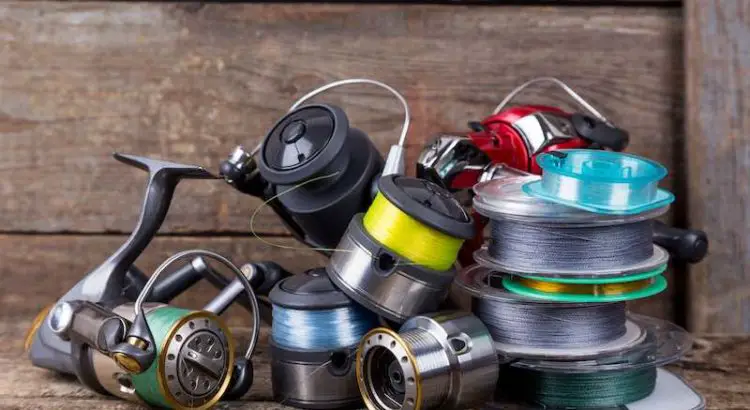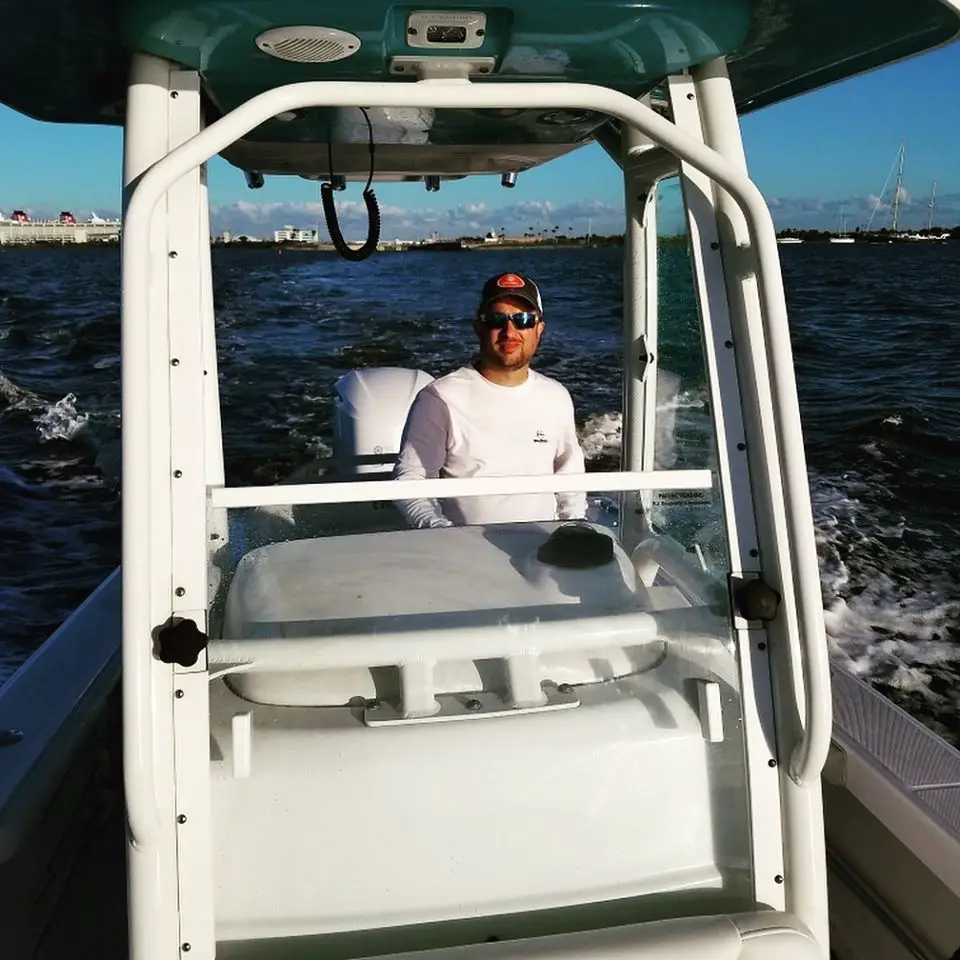This page contains affiliate links. This means that we may get a small commission for recommending products, if you choose to click on something and buy it. This does not cost you anything, but we wanted to be honest and let you know!
(Last Updated On: )Over 49 million Americans can identify with the love of fishing.
Whether it be in freshwater, saltwater, or fly fishing, or if you are angling from a boat, from a fishing kayak, or onshore, fishing is an activity that can be participated in all year round.
If you are one of the many who fish, you probably also want to make the most of the time spent doing so. In today’s world, we are busy people who need to maximize what free time we have.
Table of Contents
The Right Fishing Gear
One way to do this and make the most of your time angling is to have the right gear. Of course, you have the fishing reel, your favorite rod, and tackle box. But have you ever considered a fishing line speed spooler?
| Fishing Line Spooler | Preview | Material |
| JSHANMEI | 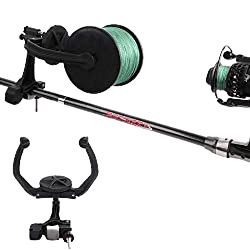 |
Composite Fiber and Metal |
| BERKLEY | 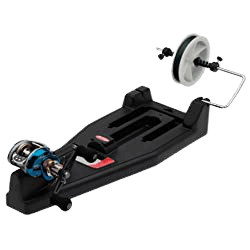 |
Composite Fiber and Metal |
| SHADDOCK | 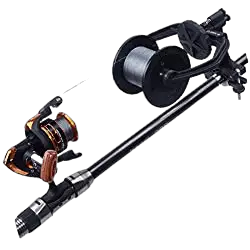 |
Composite Fiber and Metal |
| PENN HD | 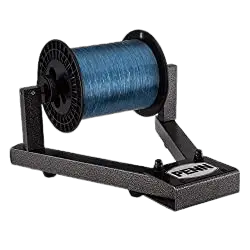 |
Steel |
| THEKUAI | 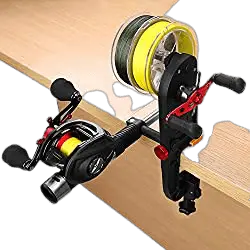 |
Composite Fiber and Metal |
You have taken the time to research and purchase the correct type of fishing line for the kind of fish you are going for. Now it is time to wind the line on the spool.
How do you spool a spinning reel? At the end of this article, we have some tips and a short video to show you how.
While it can look easy to do, it can also be frustrating winding a spool, and it seems like it takes forever to wind the line. If you are trying to do so as you are fishing, it certainly takes away from the peace of the moment and dampens the enjoyment of fishing.
No More Improvising
Some of us have used a pencil or pen to wind your fishing line onto the spool. Others have borrowed a buddy or partner.
All the time spent winding is time, and an opportunity missed, as fish wait for no one. Even then, after you have manually loaded your spool, you could have twists in the line, or the line could be loose.
Every cast is important, and twists in your fishing line are bad for your casting performance. A twist causes the fishing line to come off of the spool in a non-uniform manner.
A loosely spooled line can also damage the rest of your line during casts, hooksets, and snags by digging into the line still in the spool.
Faster Fishing Line Spooling
All of that hassle will be a thing of the past with a fishing line speed spooler. This tool is designed to make the job of winding the line on the spool easier. The speed spooler helps you to spin the line faster into a spinning, bait caster, or fly reel.
The best feature about having a fishing line winder, such as a speed spooler, is that it eliminates the upsetting line twist and knots on your spinning reels. The process takes just seconds to accomplish!
This clever fishing line winder can also be used in reverse. So when you are wanting to change the type of line that you are using, you can use a line spooler to remove the line to a spare spool for storage.
The beauty of this tool is that you can do this all by yourself, without needing someone else holding onto the spool. So if you have a bit of free time to fish, you will have the equipment to be able to go solo.
You can use a fishing line speed spooler at home before you head out, or you can take it along with you. Some spoolers mount on your rod, and others are small and lightweight enough to be portable so that it can go along for the ride.
What to Look for?
If you have decided to get a speed spooler and make your life easier, there are a couple of things to look for.
Spool Capacity
Before your purchase, make sure that your spools of fishing line can fit inside the spooler that you are interested in. If you buy your line in bulk size, you are going to want to get the largest spool capacity in a line speed spooler.
Mounting
The mounting options vary with line spoolers. Some might have a suction cup or a c-clamp. Some attach directly to your rod. When deciding on which kind to get, consider where you will be using the line spooler.
A c-clamp style will work best if you are planning to do all of your spooling at home in your workshop. If you want to take it with you, a portable one that attaches to your rod would be the best option.
The suction cup style has not gotten the best reviews from those who have used them. So unless you have a different way of mounting them in mind, you might do well to think carefully about these types.
Reel Type
If you are using different types of reels, you will want to look for rotating arm grips that allow the feeder spool to turn freely as you wind the line in.
Clamp-style fishing line spoolers usually don’t have this feature. You will want to ensure that you set up the feeder to avoid those awful line twists. In the case of baitcasting reels, the line needs to come off the top of the feeder spool.
If it is a spinning reel, the feeder line should come off the bottom of the spool.
Tension
A line spooler should allow you to adjust the amount of tension, usually by turning a knob(s) that hold the feeder spool in place.
This is essential as line tension is what prevents the line from creating backlash when you cast. Backlash (or bird’s nests) happens when the bait hits the water, and the reel keeps spinning and rolls out the line that is not pulled away from the reel because the bait is no longer moving forward.
Make sure that any spooler you purchase has a tension adjuster.
We have reviewed some of the speed line spoolers that are available out there, and have a few listed below.
Our Pick for the Best Fishing Line Speed Spooler
#1 JSHANMEI FISHING LINE SPOOLER
JSHANMEI FISHING CO. is a trading company that specializes in fishing tackle accessories. As do we, Jshanmei believes that fishing is a way to enjoy nature and refresh your mind.
They feel that your time fishing should not be used to wind a spool but in the calming experience of spending time out of doors. Their portable spooling station is designed to give you that time by speeding up the winding process.
- The spool can be adjusted to different sizes. The maximum width can be up to 5.7inches. The spooler is adaptable to a spinning reel, baitcasting reel, and round trolling reel.
- The line spooler clamp can hold the rod blank from 0.2 to 1.1inches in diameter. Use the convex surface of locking lever if your fishing rod blank is 0.2 to 0.6inches in diameter. Use the concave surface if your rod blank is 0.6 to 1.1inches in diameter.
- The spool is lightweight and small in size. It is easy to install and can be carried everywhere (whether kayaks, boats, etc.) to the spool fishing line.
- It is made of composite fiber. After assembling it using the rod clip, you can directly spool the reel on your rod and spend less time winding.
#2 BERKLEY PORTABLE FISHING LINE SPOOLING STATION
The Berkley® Portable Line Spooling Station holds up to a 3000-yard spool of line. A spring-loaded arm provides spooling tension, and a quick-release reel system makes it easy to change reels.
Use for spinning or casting reels. A spinning spool attachment eliminates line twist. Use the integrated hex shaft with a drill for even quicker spooling.
This fishing line spooling station’s compact design with a hang tab makes it easy to store or hang the unit on a wall.
- Easily spool your reels in no time with the Berkley Spooling Station.
- Handy table-top unit
- Easily adjusts for various spool sizes
- Accepts most casting and spinning reels
#3 SHADDOCK FISHING LINE SPOOLER
This tool provides an easy way to spool fishing line by yourself. It works well with spinning reels, baitcasting reels, and trolling reels.
The fishing line spool holder works great with different size spools. Just rotate the fastening knob to adjust the clamping range for different diameter line spools.
The special design will solve the problem of uneven winding, and you can spool the fishing line by yourself quickly and easily.
The fishing line spooler made of quality ABS material, and will not rust. It is stable, lightweight, and strong. It is easy to store in your vehicle and take along with you.
- Portable and a perfect size for various fishing reels such as spinning reel, low-profile reel, and round baitcasting reel
- Sturdy and Durable: Made of composite fiber with long service life.
- For Varying Spool Sizes: Easy to adjust for different line spool sizes, the maximum width of the spools is 5.7 inches
- Easy installation: simple design makes it easy to install and use. Instructions are included.
- The line spooler clamp can hold the rod blank from 0.2 to 1.1inches in diameter. Use the convex surface of locking lever if your fishing rod blank is 0.2 to 0.6inches in diameter. Use the concave surface if your rod blank is 0.6 to1.1inches in diameter.
#4 PENN HD LINE WINDER
The Penn HD line winder fishing line speed spooler can be used with a wide variety of bulk spool sizes and is designed to keep a spool of line stationery while manually winding line onto the reel.
It’s a must-have piece of gear for the serious angler. The spooler features heavy-duty steel construction and can increase and decrease tension. Once finished, it folds away for easy storage.
- Heavy-duty steel construction
- Holds filler and bulk spools
- Keeps spool of line stationery while manually winding line
- Ability to increase and decrease tension
- Folds away for easy storage
#5 PLUSINNO Fishing Line Spooling Station
This PLUSINNO Fishing Line Spooler is made of aluminum alloy, stainless steel, and ABS plastic, delivering reliable and portable performance. Its line winder works best with baitcasting, spinning, and trolling reels, featuring a two-way spooling function.
The line spooler from PLUSINNO includes additional accessories such as Concave and Convex collars, and aluminum tightening nut, steel and plastic shaft and a threaded rod.
One of the best features of this line spooler is its portability. You can spool your lines anywhere; place the clamp through a table or whatever flat surface. Then insert the stainless steel shaft into the main shaft and screw.
The PLUSINNO fishing line spooler supports multiple lines. It has a quick release that makes life easier. It is portable, convenient, and durable; a highly recommended line spooler.
- The line from the reel can be quickly reeled onto an empty spool and stored
- The unit is lightweight
- Multiple line support
- Portable and durable
How to Spool a Spinning Reel
This is a reasonably straightforward process, but we have broken it down step by step for you.
STEP ONE: Hold the fishing rod in your hand, as if you were fishing. Crank the reel a few times to determine which way the reel turns while you are cranking it.
Check to see if the reel turns clockwise or counterclockwise. This is the way that the line will be spooled onto the reel. The opposite direction is the way the line will peel off the spool when it is cast.
STEP TWO: Open the bail on the reel and remove any old line. The bail is the little wire arm on the spinning reel.
Thread the new line through the guides on your rod. The guides are a set of small wire circles that line the bottom of the rod. These guides keep the line in place.
Tie the line to the spool using an Arbor knot. After tying the knot, cut off any remaining end, leaving about ¼ inch extending beyond the knot, and close the bail.
STEP THREE: Take the spool of fishing line and place it flat on the floor. You want to place the line so that it comes off in the same direction that it will go onto the reel’s spool.
This is of particular importance to avoid a problem with the line twisting. Flip the spool to whichever side is necessary in order that it comes off correctly.
STEP FOUR: Take the line in your hand about a foot above the reel and pinch it with your fingers, keeping it taught. Some people use a cloth that has been sprayed with a special lubricant for the fishing line to draw through.
This is a personal preference. Start to crank the reel slowly, while letting the line slide through your fingers. Continue cranking the reel about 20 times and then stop and inspect the line for any twisting.
If you see twisting, you will need to strip some of the lines back off your reel and the spool of fresh line over to the other side. (See why a spooler is a good idea?)
STEP FIVE: Continue the process in Step Four until the spool is loaded with a fresh line.
STEP SIX: Once the fresh line comes within a ⅛ inch of the spool’s rim, stop adding the line. Even if you have purchased the fishing line in a bulk spool, stop at this point. You do not want to over or under load the spool as this will lead to tangles.
STEP SEVEN: Once the reel has been spooled, cut the line off near the supply spool. On the rod, tie a lure or a clip onto the free end of the line to keep it from slipping back through the guides.
Take a second to secure the end of the line in the supply spool in place so that it doesn’t unravel and leave you with a big mess. A piece of duct tape will do the trick.
Additional Tips
If you are fishing with floating baits, use a monofilament line. These lines are single-strand and have quite a bit of a stretch. This stretch makes the line more flexible and helps to keep the hook stay secure in the fish’s mouth.
For fishing in calm and shallow waters, choose a fluorocarbon line. These lines are harder for fish to see underwater, and so work very well. These lines have less stretch and hold up better to abrasion.
When you are bottom fishing, a braided line is the one to use. These lines are made of several lengths of synthetic material that are braided to create one line.
That makes a line that does not stretch. It is good for a larger casting distance, which provides a better breaking strength. This line floats and is visible to the fish, so keep that in mind.
Fishing lines come in different diameters. These diameters correspond, roughly, with the strength of the line. Typically, the thicker the line, the stronger it is.
Most fishing lines are labeled by the amount of weight that the line can support. If a line is labeled as a 10-pound test, it will support about 10 pounds of weight.
Keep this in mind when deciding what pound test line to purchase. You don’t want a line that will snap because the fish is heavier than the line, but you also don’t want to have a line that is over heavy for the type of fish.
The reason behind this is that a line that is heavier than necessary can affect the way your lure reacts in the water.
We hope that this article has been informative and helped you make the decision to make life a little easier, and your fishing experience more enjoyable. As we all know, life has enough knots and twists without adding them to your fishing line!
